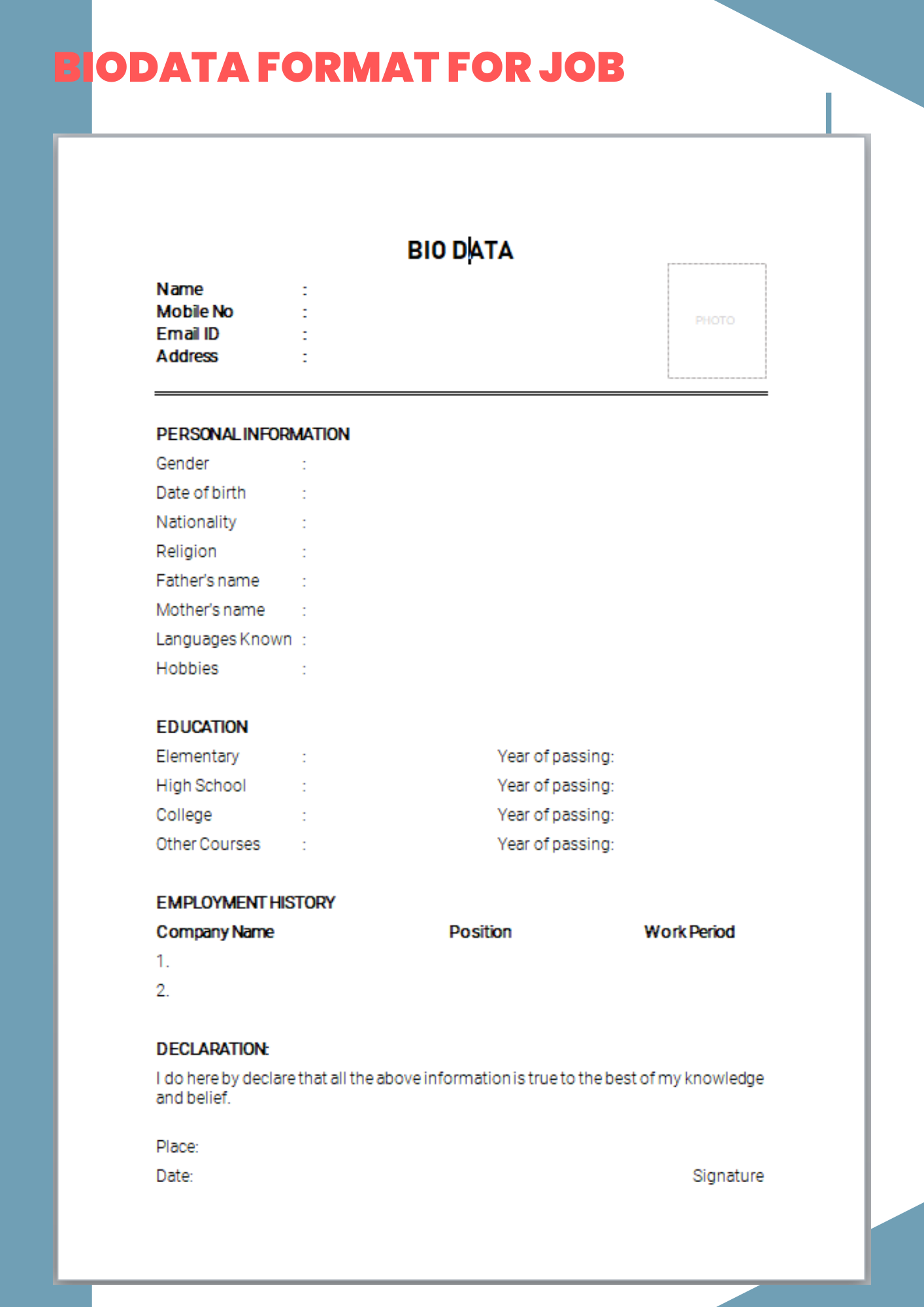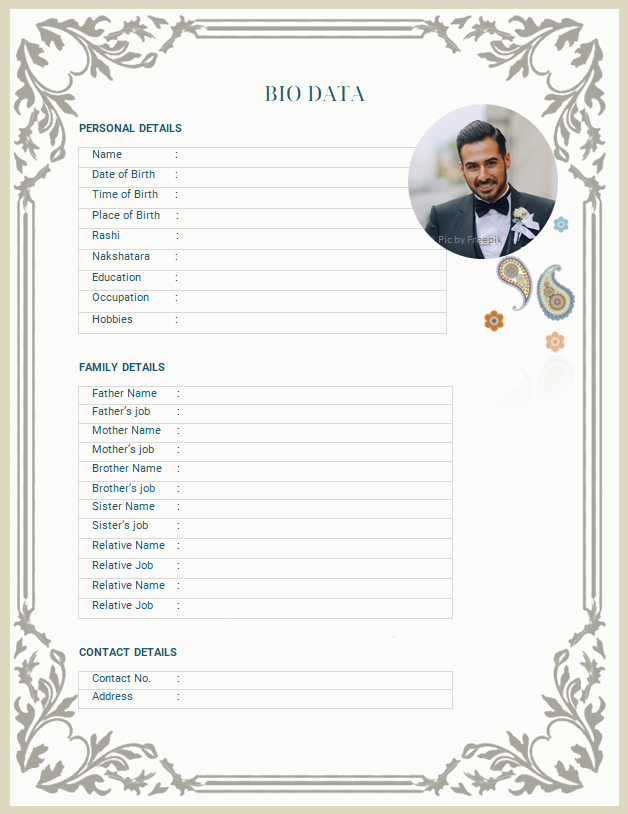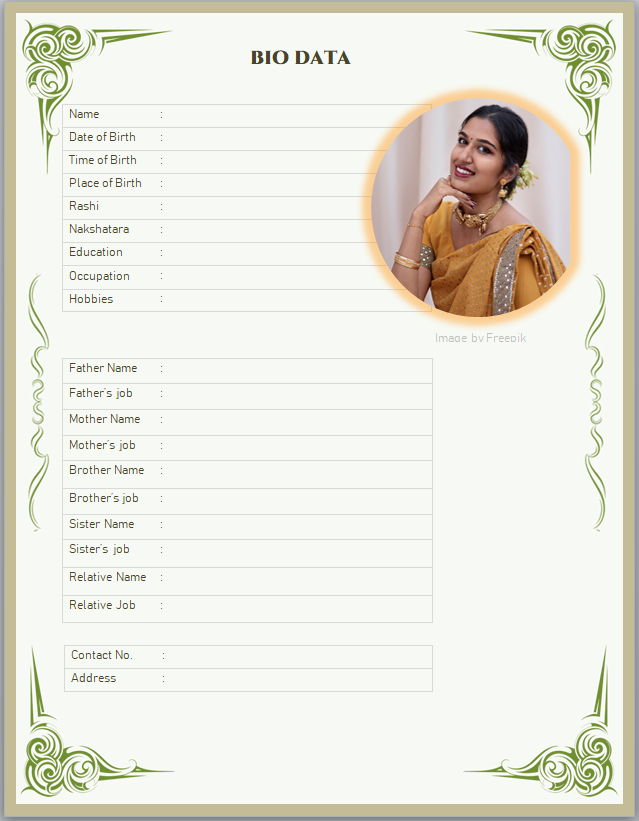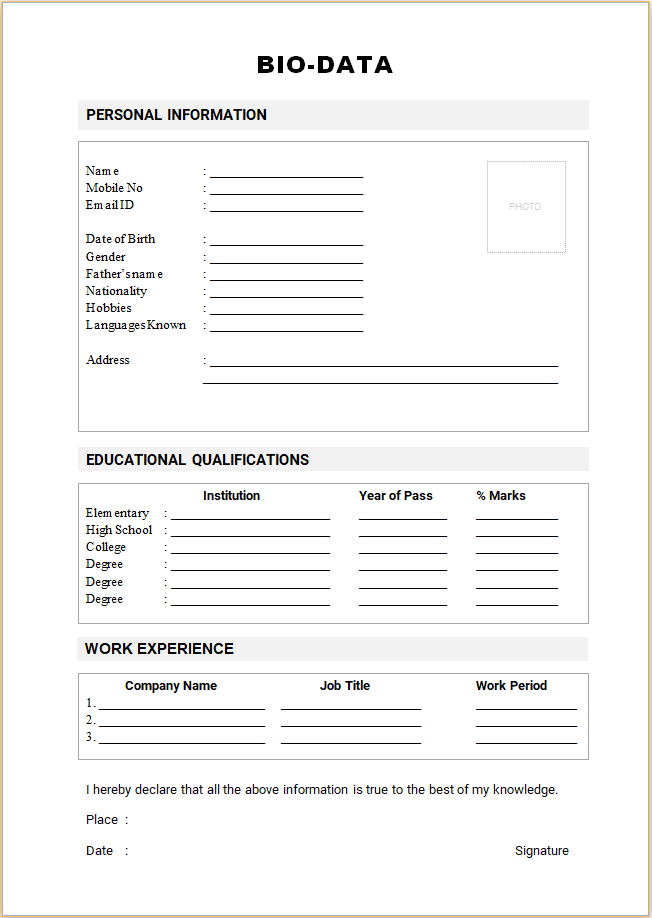Easy to edit biodata format
Biodata format for jobs

Biodata format
How to address relocation in your biodata
If you are willing to relocate for a job and want to communicate this in your biodata, it's essential to do so in a clear and professional manner. Here are some tips on how to mention your willingness to relocate and aspects to consider:
1. Include a Location Statement:
You can include a brief statement in your biodata indicating your willingness to relocate. For example:
"Willing to relocate for the right opportunity."
2. Create a Dedicated Section:
If you are open to relocation, you can create a dedicated section titled "Relocation Preferences" or "Geographic Flexibility." Here, you can explicitly mention your willingness to relocate and any preferences you might have regarding the target location.
3. Customize Your Cover Letter:
While the biodata provides a snapshot of your qualifications, you can elaborate on your willingness to relocate in more detail in your cover letter. Use this space to explain why you are open to moving and express your enthusiasm for the potential opportunity.
4. Specify Preferred Locations:
If you have specific locations in mind or are open to relocation anywhere, make it clear in your biodata. For example:
"Open to relocation across [List of Preferred Locations]."
5. Addressing Relocation Costs:
If you are willing to cover your relocation costs or have arrangements in place, you can mention this in your biodata. This can be reassuring for employers concerned about the practicalities of relocation.
6. Be Honest and Clear:
Clearly communicate your intent and be honest about your willingness to relocate. Ambiguity or lack of clarity can lead to misunderstandings, so it's important to state your preferences explicitly.
7. LinkedIn or Online Profiles:
If you have a LinkedIn profile or an online professional portfolio, ensure that the information about your willingness to relocate is consistent across platforms. Employers may check multiple sources for information.
8. Check Job Listings:
Some job listings may explicitly mention whether the position requires relocation or if the company is open to candidates willing to relocate. Tailor your application accordingly and, if necessary, address your willingness to relocate in your cover letter.
9. Research the Company's Locations:
If you are applying to a company with multiple locations, research each location and express your openness to working in any of them. This shows that you are well-informed and flexible.
10. Update Contact Information:
Ensure that your contact information, particularly your phone number, reflects your current location. This can prevent misunderstandings and help employers reach out to you promptly.
Clear communication is key. By being transparent about your willingness to relocate, you increase the chances of aligning with employers who have suitable opportunities in different locations. Tailor your messaging to suit your preferences and the expectations of the industry you are targeting.
Additional Inputs
File formats for sharing biodata
Sharing your biodata in the right format is crucial to ensure that it can be easily accessed and viewed by employers. Here are simple guidelines on the file formats for sharing biodata:
PDF (Portable Document Format):
Advantages: PDF is a widely accepted and standardized format. It maintains the formatting of your biodata, ensuring that it looks the same across different devices.
How to Share: Save your biodata as a PDF file before sharing it. When you send it, the recipient can open and view it using various software, and it's less likely to be altered unintentionally.
Word Document (DOCX or DOC):
Advantages: Word documents are editable, making it easy for employers to extract and use specific information. They are commonly used in the professional environment.
How to Share: Save your biodata as a Word document (either DOCX or DOC format) if you want to give the recipient the flexibility to make edits. However, be cautious about potential formatting changes.
Plain Text (TXT):
Advantages: Plain text files are universal and can be opened on almost any device. They are simple and contain only plain text without formatting.
How to Share: If requested, you can share a plain text version of your biodata. However, note that it won't include any formatting or stylized elements.
Online Platforms and Links:
Advantages: You can also share your biodata by providing a link to an online profile or portfolio, such as LinkedIn or a personal website.
How to Share: Include the link in your email or job application. Ensure that your online profile is complete, professional, and aligned with the information in your biodata.
Tips
Before sharing, review your biodata in the chosen format to ensure it appears as you intend.
If the employer specifies a preferred format in the job listing, adhere to those guidelines.
Avoid sharing your biodata as image files (e.g., JPEG or PNG) as these are not easily editable, and text extraction can be challenging.
In summary, PDF and Word document formats are commonly preferred for sharing biodata. Choose the format that aligns with the employer's preferences or specifications. Always consider the ease of access and the ability of the recipient to view and understand your biodata without any issues.


